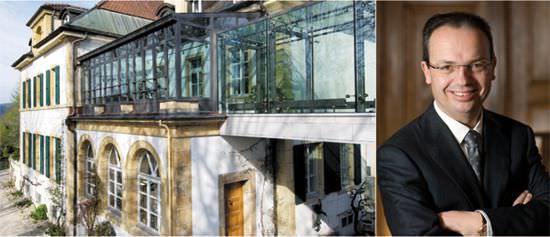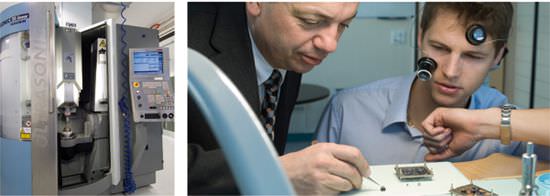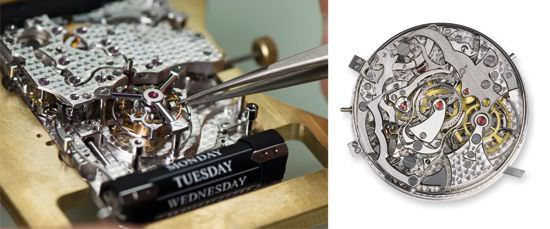To tell the truth, the most impressive watchmaking ‘platter’ that I have seen this year was that at the ‘quality control’ bench of the Christophe Claret manufacture. One could say it was the most sophisticated platter of delicacies on the market today except that it is really quite weighty. Just think about it for a minute. Sitting side by side are a Jean Dunand Tourbillon Orbital carved from a rare gemstone, a Jean Dunand Shabaka, a deLaCour bi-minute repeater (which chimes GMT hours and has a shooting star appear over the course of its operation), a Colosso GMT minute repeater signed Jorg Hysek (and decked out with a mini terrestrial globe at 12 o’clock figuring prominently under a sapph-ire crystal), a Harry Winston Tourbillon GlissiÈre, an incredible minute repeater by Guy Ellia (that is protected by a 360° sapph-ire crystal) and even a Chapter One timepiece from MaÎtres du Temps. Certainly nothing to be ashamed of!
The watches of this kind and complexity that come out of the Christophe Claret atelier number only about 420 a year. Yet, for the most part—90 percent—they are created in-house by 115 people, including 40 skilled watchmakers.

Ten years, 63 in-house calibres
In 2000, Christophe Claret purchased a beauti-ful manor house, Le Soleil d'Or (The Golden Sun), which had been built at the beginning of the 20th century by the watchmaker, Urban JÜrgensen. It is situated at the upper reaches of Le Locle, just below the Château des Monts watch museum.
Since that time, the dwelling has seen its size grow by the addition of two ultra modern wings that the lord of the manor shows off with unabashed delight. Claret has good reason to be proud of this facility since, in a small and compact space, it is one of the highest performing complete manufactures around, as well as also being one of the most modern and innovative. In hardly ten years, its team has created 63 original in-house calibres, of which the simplest is a tourbillon.
The day of our visit, the ateliers are working on 46 different calibres, all at the same time. The least expensive timepiece to come out of the Claret site costs CHF 35,000 (Euro 23,000), while the most expensive can climb to as high as CHF 120,000 (Euro 79,000). This is ‘wholesale’ of course. To get the retail price, you can multiply these numbers by four, five, six, or even seven depending upon the brand. We leave you to calculate the public prices while we take a tour of the manufacture.

Mutual pollination
For the tour, two options are open to us. We can follow the birth of a product step by step, from its ‘debut’ to the end of its production cycle, or depending on the hallways and the areas, we can observe the diversity and essential coordination of all the tasks that are vital for the creation and production of a watch. These timekeepers are not born as orphans or by spontaneous conception; each one nourishes the other, we might say. An improvement in one watch will also bring a major innovation to another. The savoir-faire, the skills and dexterity, and the ingenuity inside this facility circulate throughout and pollinate one another.
Logically and chronologically, we should begin our visit with the research department where a dozen constructors are busy at work. But here, we can immediately see the first example of this mutual ‘pollination’. The research department for calibres is located right next to the one specializing in cases. Christian Cartier, responsible for design and technical follow-up of the cases, explains that those “destined to receive very specific and complex movements must necessarily be as sophisticated as the movements they contain, protect and showcase. And, just like the construction of the calibres, the construction of the cases involves a continuous search for innovation. Examples include articulated horns, lateral openings, fold-over articulated clasps, etc.”
To energize this recently created cases unit even more, the Claret manufacture collaborated in creating a ‘monster’ and is now impatiently awaiting its delivery. This amazing new 17-axis CNC machine is capable of working in pairs of two times five axes. This will not only cut operational time in half but, by minimizing handling and adjustments, it will also provide excellent tooling precision.

Fascination with mechanization
This exclusive equipment is only one example, among many, of machinery that has been specifically developed for the Claret site. In fact, Christophe Claret speaks of his machines with the same passionate and almost childlike enthusiasm that he speaks of his movements. Whether they are the Tornos Elwin and the new Citizen lined up on the immaculate floor of the cutting and milling atelier (whose manager shows us microscopic plates, ultra fine cams and even the ‘combed’ screws on the burin that are not threaded—which takes less time, but weakens the material) or the small CNC pivot burnishing tool in the adjacent workshop that has a tolerance of one micron and permits the hardening of the pivot’s surface, which must be perfect. As a note, this type of artistry is rather rare, to the point that all burnishers in Switzerland have been trained by the same elderly individual who is the only remaining expert still alive from the old school. He teaches them to estimate the surface state of the pivot by ear, by listening to the sound of the metal against the tool.
Not far away, in the Ebauche department, another machine makes its owner proud: The Flashcut laser. Developed by the Claret engineers in collaboration with BC-Technology, this tool is used to cut out 70 percent of the components used by the manufacture. In four hours, it does the work of five electro-erosion machines and operates 24 hours a day. The savings in time and energy make all other machines seem like ‘dinosaurs’.
In the same atelier, a Witech machine tool, used up to now only in the automobile industry, has been adapted by Claret to satisfy certain watchmaking needs. Its system allows the automatic replacement of 96 tools while the auto-control of pieces in production provides for automatic corrections.
“I always want to have a very progressive vision of the modes of production,” explains Christophe Claret, “and to be as innovative in the domain of equipment as in the realm of watchmaking.” He has other objectives as well. Besides providing the ’always-welcome’ autonomy, a mastery of the fabrication processes lets the company be much more reactive in decreasing deadlines and permits it to have ‘real time’ research and innovation, thus also being more economically decisive.
But, we are not allowed to see some of this cutting-edge machinery—the company’s top secret equipment. For example, we cannot visit the room where the sapphire crystals are finished. Its doors remain hermetically sealed, with entry permitted to authorized personnel via a finger print scanner. In this workshop, it seems that ‘specific’ procedures are used to polish recesses in the crystal. Next door, we can see the more classic equipment that cuts and polishes the sapphire crystal, but only on the flat side.
Among the other production workshops that we can freely visit are: the thermal treatment atelier where metals are tempered and then polished; the room for electroplating, using yellow, pink, or anthracite gold as well as rhodium-plating in white or black colours; the impressive atelier where chamfering is conducted by no less than 15 individuals working together; and lastly, the decoration workshop where finishes such as the CÔtes de Genève and circular-graining, among other patterns, are carried out.

Management, coordination, control
We can easily imagine that managing these many operations is especially critical when so many pieces are being worked on, and in such small quantities. There are 12,000 references on the list, which means 12,000 task lists and more than two million pieces in production and in stock in the manufacture’s ‘Treasure Chamber’. It is here, where the computer controlled stock system holding finished and unfinished pieces can be found and where kits are prepared—of which 80 percent are used in-house with the remaining 20 percent sent to the brands that ordered them.
Around this central nervous system are a number of offices. Four people in the ‘Methods Office’ develop the task lists for production, while three people in the logistics office manage the technical follow-ups, control the internal and external production deadlines and manage the component parts of the 18 clients of the manufacture. The technical office is responsible for developing new calibres and the office for finishing handles electroplating, tempering, decoration and gears. The role of each office is, of course, vital. Each must ensure a good flow of products and services as well as dealing with emergencies, all while resolving any technical problems and monitoring the finishing (100 percent of parts are finished in one way or another).
So, we might ask, where do the watchmakers figure in all of this? We nearly forgot them, but they are certainly present. More than forty are spread throughout the large workshops specializing in assembly and the creation of tourbillons—an important house specialty. Besides the assembly of the tourbillon carriages, which are entrusted to seasoned specialists, each watchmaker assembles his or her own watch from A to Z. Each atelier is also equipped with small, networked computers that provide all the necessary assembly instructions and steps. They are also directly linked to the managers who can thus supervise and control the progress of the pieces.
During the entire process, the quality control department—made up of five people—plays a crucial role. Not only does this entity scrupulously check all the watches, in terms of both function and aesthetics, before according them their certificate of approval, but it also checks all of the component parts, both in-house and those originating on the outside. Somewhat dreaded, the quality control office is equipped like a police scientific laboratory and has the power of ‘life or death’ over production.

The power of the image
It is now time to return to where we started our tour—the research department. Determined to create a company as autonomous as possible, Christophe Claret not only has the most advanced research department, where calibres are created with the latest 3D software, but he also insists on extreme rigour in product development.
All steps in the elaboration and mechanical construction process are systematically validated by a co-constructor, by the technical director, and by Christophe Claret himself. By pushing the limits of research as far as possible, the stated ideal goal is to have “prototypes that function correctly nearly always the first time”. While perhaps never really attained because haute horlogerie always requires the finesse of that last human touch, this ideal situation is, it seems, constantly and determinately attempted.
This determination has led Claret to create his own ‘Office of Computer Graphics’ right next door, which employs two experts in the field of imaging. As Claret is quick to point out, however, “We don’t create images in order to sell products that don’t yet exist, but rather to show off the beauty and complexity of our work as well as to share and demonstrate the sophistication of our movements in which we can delve virtually.”
And, we can see in this virtual world the human touch that we mentioned earlier since all the images are produced from real textures, materials, finishings and decorations that were created in the manufacture and then digitalized, thus providing a gigantic library of textures that are used to generate images with astonishing realism. Enamoured with images, Christophe Claret has recently installed what is probably the first private theatre equipped with 3D projection capabilities in Switzerland. Here he enjoys screening the recent film made in 3D about the manufacture. (I can attest that the realistic immersion is truly amazing.)
Is there a Claret style?
As the visit comes to an end, we can legitimately ask the question: Is there a Claret style, a style that is the ultimate expression of this manufacture and its organization?
We are convinced that there is. A product, in both its appearance and in the inner workings of its mechanical operation, cannot remain indifferent to the manner in which it was designed and produced. Despite the great diversity in the timekeepers that are created in the Claret facilities, we must say that Christophe Claret’s fascination with machines, the processes, the savoir-faire and the innovations are all the same in the various products he creates.
Connecting rods, rollers, animations, chimes, mechanical ballets…they are all there. The mechanical is not hidden. On the contrary. It is proudly displayed. It can be discovered under the sapphire crystals. It plays with volumes and depths. It is a little like a child’s dream that has come true. A small twinkle in Christophe Claret’s eyes says that we are not mistaken.
Source: Europa Star August-September 2009 Magazine Issue





